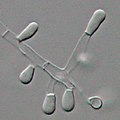Trichophyton tonsurans
Trichophyton tonsurans[edit]


Trichophyton tonsurans is a fungus that is a common cause of dermatophytosis, particularly tinea capitis, which is an infection of the scalp. It is an anthropophilic fungus, meaning it primarily infects humans.
Description[edit]
Trichophyton tonsurans is characterized by its ability to invade the keratinized tissues of the body, such as the skin, hair, and nails. The fungus produces macroconidia and microconidia, with the latter being more common. The colonies of T. tonsurans are typically flat, with a suede-like texture and can vary in color from white to yellowish-brown.
Pathogenicity[edit]
Trichophyton tonsurans is a major cause of tinea capitis, especially in children. The infection is highly contagious and can spread through direct contact with an infected person or through contact with contaminated objects such as combs, hats, or towels. Symptoms of tinea capitis include itching, scaling, and hair loss in the affected area.
Diagnosis[edit]
Diagnosis of Trichophyton tonsurans infection is typically made through clinical examination and confirmed by laboratory tests. Microscopy and culture of skin scrapings or hair samples can be used to identify the fungus. Molecular techniques such as PCR may also be employed for more accurate identification.
Treatment[edit]
Treatment of infections caused by Trichophyton tonsurans usually involves the use of antifungal medications. Oral antifungals such as griseofulvin or terbinafine are commonly prescribed for tinea capitis. Topical antifungal treatments may also be used in conjunction with oral medications.
Epidemiology[edit]
Trichophyton tonsurans is found worldwide but is more prevalent in certain regions. It is a leading cause of tinea capitis in North America and parts of Europe. The fungus is particularly common in urban areas and among populations with close living conditions.
Prevention[edit]
Preventive measures include maintaining good personal hygiene, avoiding sharing personal items, and treating infected individuals promptly to prevent the spread of the fungus. Regular cleaning and disinfection of potentially contaminated objects can also help reduce transmission.
Related pages[edit]
References[edit]
- Gupta, A. K., & Summerbell, R. C. (2000). "Increased incidence of Trichophyton tonsurans tinea capitis in Ontario, Canada between 1985 and 1996." Medical Mycology, 38(2), 155-162.
- Hay, R. J., & Moore, M. K. (2004). "Mycology of scalp ringworm." Journal of the American Academy of Dermatology, 50(1), 1-20.
-
Trichophyton tonsurans under a microscope
-
Colony of Trichophyton tonsurans
-
Brodmann area map
Ad. Transform your life with W8MD's Budget GLP-1 injections from $75


W8MD offers a medical weight loss program to lose weight in Philadelphia. Our physician-supervised medical weight loss provides:
- Weight loss injections in NYC (generic and brand names):
- Zepbound / Mounjaro, Wegovy / Ozempic, Saxenda
- Most insurances accepted or discounted self-pay rates. We will obtain insurance prior authorizations if needed.
- Generic GLP1 weight loss injections from $75 for the starting dose.
- Also offer prescription weight loss medications including Phentermine, Qsymia, Diethylpropion, Contrave etc.
NYC weight loss doctor appointmentsNYC weight loss doctor appointments
Start your NYC weight loss journey today at our NYC medical weight loss and Philadelphia medical weight loss clinics.
- Call 718-946-5500 to lose weight in NYC or for medical weight loss in Philadelphia 215-676-2334.
- Tags:NYC medical weight loss, Philadelphia lose weight Zepbound NYC, Budget GLP1 weight loss injections, Wegovy Philadelphia, Wegovy NYC, Philadelphia medical weight loss, Brookly weight loss and Wegovy NYC
|
WikiMD's Wellness Encyclopedia |
| Let Food Be Thy Medicine Medicine Thy Food - Hippocrates |
Medical Disclaimer: WikiMD is not a substitute for professional medical advice. The information on WikiMD is provided as an information resource only, may be incorrect, outdated or misleading, and is not to be used or relied on for any diagnostic or treatment purposes. Please consult your health care provider before making any healthcare decisions or for guidance about a specific medical condition. WikiMD expressly disclaims responsibility, and shall have no liability, for any damages, loss, injury, or liability whatsoever suffered as a result of your reliance on the information contained in this site. By visiting this site you agree to the foregoing terms and conditions, which may from time to time be changed or supplemented by WikiMD. If you do not agree to the foregoing terms and conditions, you should not enter or use this site. See full disclaimer.
Credits:Most images are courtesy of Wikimedia commons, and templates, categories Wikipedia, licensed under CC BY SA or similar.
Translate this page: - East Asian
中文,
日本,
한국어,
South Asian
हिन्दी,
தமிழ்,
తెలుగు,
Urdu,
ಕನ್ನಡ,
Southeast Asian
Indonesian,
Vietnamese,
Thai,
မြန်မာဘာသာ,
বাংলা
European
español,
Deutsch,
français,
Greek,
português do Brasil,
polski,
română,
русский,
Nederlands,
norsk,
svenska,
suomi,
Italian
Middle Eastern & African
عربى,
Turkish,
Persian,
Hebrew,
Afrikaans,
isiZulu,
Kiswahili,
Other
Bulgarian,
Hungarian,
Czech,
Swedish,
മലയാളം,
मराठी,
ਪੰਜਾਬੀ,
ગુજરાતી,
Portuguese,
Ukrainian


